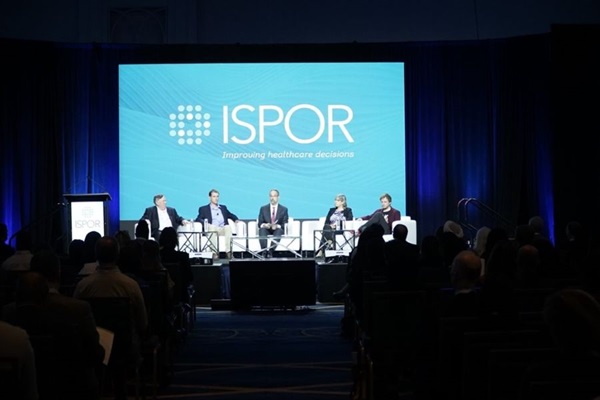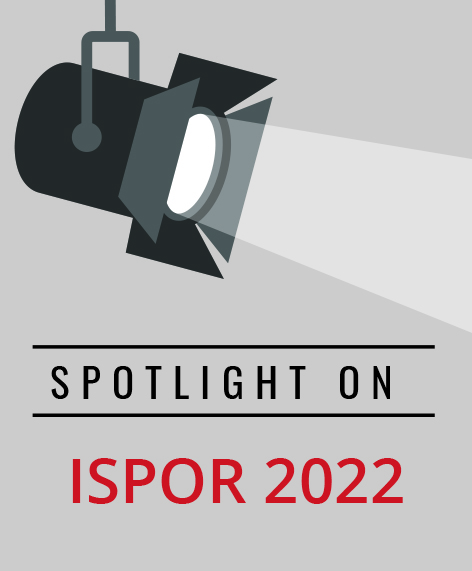Opening Day Plenary Features Discussion on HTA on the Run
Ingrid Cox, MD MSc, Menzies Institute for Medical Research, University of Tasmania, Hobart, Tasmania, Australia
The session began with a warm welcome by ISPOR CEO and Executive Director Nancy S. Berg to all 3600 participants at the conference, attending by live stream from 53 countries and in person from 57 countries around the world. Her message was clear: “ ISPOR is back!” Focusing on the past challenges of the pandemic and the current challenges faced by several members, in particular members from Ukraine, she commended the resilience of ISPOR members to triumph despite these difficult circumstances. She spoke to the fact that ISPOR, like its members, had evolved during the pandemic—and continues to evolve—to meet the needs of members with virtual programming, accelerated activities, and active member engagement. All of which has resulted in a larger post-pandemic membership. She concluded by announcing ISPOR’s new President-Elect Brian O’Rourke, PharmD, thanking the conference co-chairs, Ran D Balicer, Eberechukwu Onukwugha, Daniel A. Ollendorf, the conference program committee, and all the sponsors of the conference.

Nancy Berg welcomes everyone to ISPOR 2022
Isao Kamae, DrPH, MD, ISPOR President for the 2021-2022 term and the first from Asia, was delighted to address the attendees to the first in-person ISPOR conference since the pandemic. He reminded the audience of his goals and vision for the organization, outlining his interpretation of the ISPOR acronym as Involved, Scientific, Professional, Outstanding, and Resilient. He was grateful to have played a part in ensuring that a stable and evolving Society was transitioned to the new ISPOR President Jan Elias Hansen, PhD. He concluded by extending his gratitude to the ISPOR Board of Directors and the ISPOR Staff, which he described as “the engine of ISPOR.”
The next speaker, Eberechukwu Onukwugha, PhD, introduced the moderator and speakers for the eagerly awaited “HTA on the Run” panel discussion. The session was moderated by Ran D Balicer, MD, PhD, MPH, and included panelists Noa Dagan, MD, PhD, Simon Reif, PhD, and Douglas Kelly, MD, MBA, and Dr Joseph Ross, MD MHS.

Seated left to right: Douglas Kelly, Joseph Ross, Ran Balicer, Noa Dagan, and Simon Reif.
Balicer began the discussion by providing some introspection on the transformation of the healthcare industry with the accelerated pace of emergence of innovative digital technologies. He noted that in the United States alone, venture funding for digital technologies had increased over the past decade by 72%; $14 billion was invested in 2020 and the amount increased to $29 billion in 2021. Notwithstanding the large investment, he highlighted that adoption was relatively slow mainly due to regulation and reimbursement policies. Removing these barriers, Balicer noted, would require complementary innovation in regulatory and reimbursement policy. He highlighted that these processes were important as they provided quality digital technologies that provided “ the right care for the right patient at the right time for the first time.” The case studies that followed provided examples of innovative methods to overcome the challenges to implementation of new technologies.
Joseph Ross, MD, MPH (Yale University, USA) provided an overview of the regulatory system governing digital technology in the United States, accentuating the risk classification which differentiated it from pharmaceutical regulation. The regulatory pathway is then specified based on risk classification. Authorization pathways include the pre-market approval, 510k clearance, de novo breakthrough devices program, and software as a medical device. Clinical trials for safety and effectiveness were required for the pre-market approval and de novo pathways but not for other pathways during the regulatory process. He noted that approximately 95% of products on the market were approved via other pathways other than de novo and pre-market pathways. Given this, the need for practical methods—whether through real-world data or pragmatic clinical trials—to test these devices is important.
Next, Douglas Kelly, MD, MBA (US Food and Drug Administration [FDA], USA) focused on future plans at the FDA to improve the regulatory process. He highlighted the fragmentation within the regulatory system especially related to the numerous stakeholders, varying requirements of each stakeholder based on their area of specialization, and lack of communication between these sectors. Future systems will bring all stakeholders together at the initial stages of the process, which will eliminate delays and result in safer, more effective devices in a shorter timeframe. This is the basis of the Total Product Lifecycle Advisory Program that improves communication with and at the FDA.
Noa Dagan, MD, PhD (Clalit Health Services, Israel) presented a case study on digital technology used within the Israeli healthcare system to ensure quality care for patients. The digital platform supports clinical decision making for physicians and general practitioners to provide proactive preventive and personalized care for their patients. This is done using artificial intelligence prediction models based on real-world data, which identify patients at high risk for future deterioration or future conditions based on current profiles or conditions that they currently have. It also reduces information overload for physicians by consolidating clinical pathways to provide personalized treatment and management recommendations based on current literature reducing timelines for patient management. The platform currently boasts an adherence rate of over 95% among physicians. In response to the presentation, Ross mentioned that while this was impressive, an evaluation was necessary to determine whether physician behavior change translated to improved quality care for patients, which would be a long-term outcome. Dagan also provided an example of how the technology is used to simulate clinical trials using real-world data (including randomization) using “digital twinning.” She noted that this was used during the pandemic to demonstrate the effectiveness of vaccines.
The last speaker, Simon Reif, PhD (ZEW, Germany), provided the audience with an overview of the German DiGa pathway that provides rapid access for low-risk digital technologies or software that demonstrates benefits to patients. This pathway allows innovators to be a DiGA for 1 year, during which time they collect additional data to demonstrate evidence of patient benefit or effectiveness while the technology is reimbursed by the social insurance system. It provides opportunities for smaller companies or innovators.
The session concluded by fully recognizing that digital health is transforming healthcare around the world. And while there is accelerated innovation in the field, countries have used different models to adapt to the situation and HEOR was central to this process.

